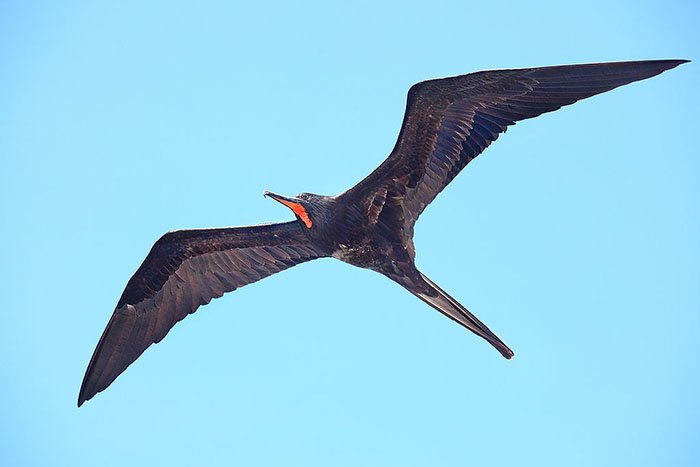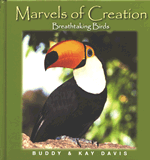Frigatebird
The frigatebird is a large semi-tropical to tropical seabird with a forked tail. Male frigatebirds, which are glossy black, are easily recognized by their red throat pouches. Females are black with a white breast and shoulder. To attract a mate, males blow up their red throat pouches like big balloons while they dance and let out a shrill call.
Frigatebirds spend most of their time in the skies above the open ocean and can stay in flight for weeks at a time. Scientists attached tracking devices and special equipment onto several frigatebirds and monitored them as they flew. They were surprised by what they found.
- Frigatebirds can fly 12,000 feet (4,000 meters) above the ocean waters. The air is usually very cold that high up.
- The frigatebird’s heart rate stays at a normal rate as it glides for hours very high in the air. This means they aren’t even working hard to stay in flight.
- Unlike most other seabirds, frigatebirds don’t have waterproof feathers, so they will drown if they spend more than a minute or two in the water. This means they aren’t resting on the water during those weeks at sea.
How does the frigatebird fly for weeks at a time without getting tired? God has designed this large seabird with some incredible features to help it thrive in its environment.
Frigatebirds have the largest wingspan compared to their body weight of any bird. These are the perfect dimensions to help them glide expertly and stay in the air for days at a time with very little effort.
Frigatebirds are the only birds that purposefully fly into clouds. They find big fluffy clouds (called cumulus clouds) to fly into. These clouds form over the ocean where warm air rises. This forms an updraft, and the bird can ride up with almost no effort. This strategy works so well one bird flew for 40 miles (64 kilometers) without flapping its wings!
In our post-Fall world, frigatebirds eat fish and other sea creatures. How do they catch food if they can’t land in the water? They have a unique feeding strategy. When bigger fish or dolphins find a big school of tiny fish, they start what’s called a “feeding frenzy.” The little fish try to jump out of the water, and the frigatebirds swoop down to grab them.
Another way they get food is by pestering other birds, forcing them to regurgitate (throw up) their food. The frigatebirds snatch the food out of the air before it hits the water. To us, it seems really gross, but it gets these seabirds the food they need.
Here are some fun facts about frigatebirds.
- Frigatebirds are also known as “the condor of the oceans,” “Man O’ War,” and “pirate birds.”
- Frigatebirds are the only seabirds that have a very different looking male and female.
- Frigatebirds care for their chicks for over a year, which is the longest of any known bird kind. The father cares for the chick for three months and the mother for nine months.
- Frigatebirds build a flat or slightly bowl-shaped platform of sticks as a nest and lay one white egg. They often steal their nesting material from other seabirds.

By Benjamint444 via Wikimedia Commons
Class: Aves
Order: Suliformes
Family: Fregatidae
Genus/Species: Fregata magnificens
Size: 34–44 inches long (89–114 cm) with a wingspan of 7 feet (2 meters).
Weight: 2.2–3.5 lbs (1,000–1,590 grams). The females generally weigh more than males.
Diet: Fish, squid, turtles, crabs, jellyfish, scraps thrown off fishing boats.
Habitat: Frigatebirds spend most of their time at the open sea, but they nest in mangrove cays (a kind of tree that stands out of the water) and on trees and bushes.
Life Span: The oldest recorded frigatebird was at least 19 years old.
Special Design Feature: With its long wings and relatively small body, the frigatebird is a very good flier and can twist and turn easily. This helps it catch food out of the air.
Did You Know?
Frigatebirds got their other names “Man-O-War” and “pirate birds” because of their habit of stealing other birds’ food.
Learn More
Recommended Resources
- © 2024 Answers in Genesis
- Privacy Policy
- Contact
- About

